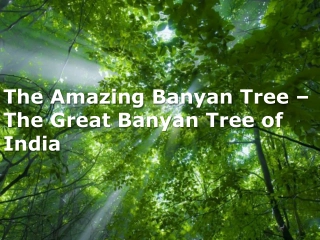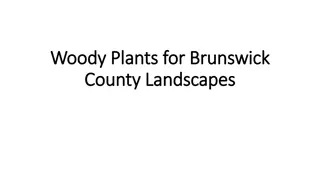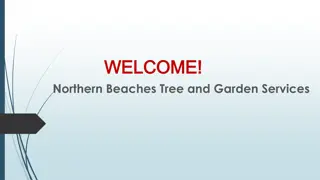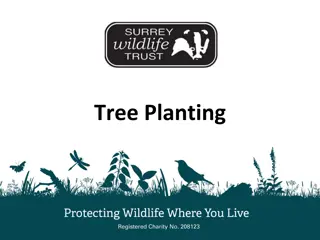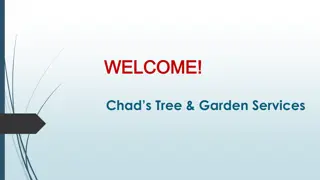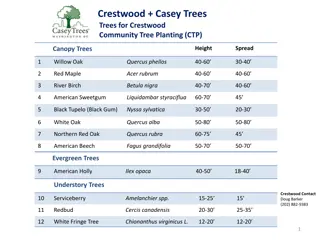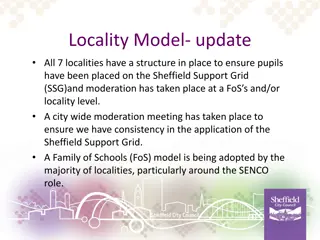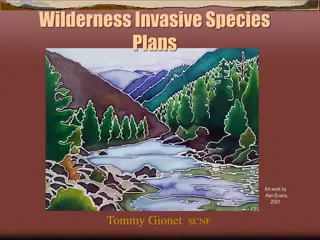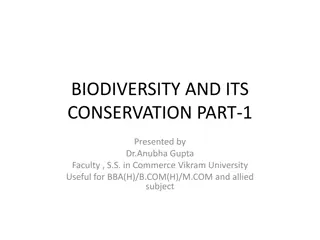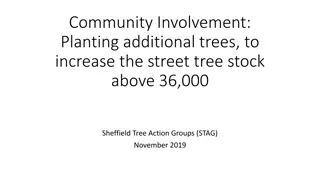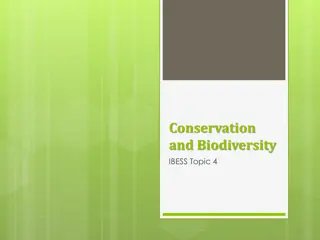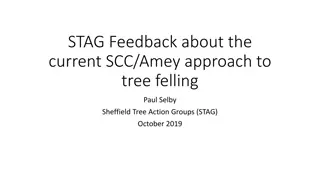Evaluating Tree Species Diversity for Planting in Sheffield: A Review of Amey's List
The article discusses the positive aspects and areas for improvement in the list of tree species used by Amey for planting new saplings in Sheffield. While the expanded list shows promise in enhancing variety and resilience, there are concerns about the wildlife value, canopy size, forward-thinking choices, maintenance focus, consideration of potential threats, and suitability to local conditions. Recommendations include incorporating more diverse and wildlife-friendly species, reevaluating disease-resistant varieties, and ensuring alignment with current knowledge on tree health threats.
Download Presentation

Please find below an Image/Link to download the presentation.
The content on the website is provided AS IS for your information and personal use only. It may not be sold, licensed, or shared on other websites without obtaining consent from the author.If you encounter any issues during the download, it is possible that the publisher has removed the file from their server.
You are allowed to download the files provided on this website for personal or commercial use, subject to the condition that they are used lawfully. All files are the property of their respective owners.
The content on the website is provided AS IS for your information and personal use only. It may not be sold, licensed, or shared on other websites without obtaining consent from the author.
E N D
Presentation Transcript
Views on the Amey list of tree species used when planting new saplings Sheffield Tree Action Groups (STAG) September 2019
Positives The (expanded) list Darren Butt showed us in September 2018 is a long list of 78 species It includes many species and genus unused (or barely used) in the 36,000 trees Amey inherited in 2012 If used in full, it really would increase the variety and disease/pest resilience of the tree stock in Sheffield
Areas for improvement Many species are not useful to wildlife Many of the Cherry species used are of varieties which have limited nectar value to insects such as bees Others also of really low value to wildlife (eg Ginko) Canopy size small (either fastigiate or small cultivars), again limiting the wildlife value
Areas for improvement The list could be more forward thinking and innovative The elm species used are not ideal. Whilst DED resistant, they are Asian cultivars. There are much better DED resistant varieties now available eg Fiorente , Rebona and Wingham helping to promote varieties that are close to native Field Elms The Sorbus varieties used could include some of the very rare native varieties eg Wild Service, and Wilmott s Whitebeam These would help to increase the population of threatened native trees which also have wildlife value
Areas for improvement Extreme focus on low maintenance varieties Fastigiate trees are clearly most appropriate in some circumstances for example on narrow terraced streets But canopy is king in terms of the various benefits. Similarly, many of the species are slow growing, or small at full size Need to only use small and/or fastigiate trees where absolutely necessary. Full size trees in all other circumstances
Areas for improvement Does it really take into account the latest thinking on likely tree diseases and pests soon to enter the UK? DEFRA have a list on their website of the likely next threats the known knowns and known unknowns Does the Amey species list fully take this into account?
Areas for improvement Incorrect species for location Are local conditions always thought about? Wind resistant trees in windy spots? Drought resistant trees in areas baked by sunshine Trees that don t mind waterlogged conditions in areas prone to flooding, or in heavy clay Needs to take account of "special" areas - these include conservation areas, memorial trees, avenues, and the fact that 1/3 of Sheffield District is in the Peak National Park where specific rules may apply to what you can plant. Some species selection has been odd: Black Pine on corner of narrow pavement London Plane in an avenue of 96 Lime trees Lime tree in a tree pit of a Lime that died from fungus
Areas for improvement Earlier flowering species could be used Early emerging insects struggle to find nectar Could more early flowering trees be used? eg add Magnolia, and increase the use of both Birch and the right sort ofearly flowering Cherry
Areas for improvement Undersize trees being planted Even ignoring the species list, the specimens being sourced do not always meet the contract requirements in terms of girth and height for new plantings Leaves them vulnerable and gets them off to a bad start Not just odd examples large numbers
Areas for improvement Care after planting Care after planting leaves a lot to be desired Watering regime is part of the contract and was not adhered to Weeds in tree pit also Is the use of woodchip as mulch appropriate? takes nitrogen from the soil when it decomposes, Liberal use of weedkiller to kill weeds in pavement cracks and into tree pits . Lots of examples of strimmer damage to new saplings completely careless
Summary The Amey species list is a start, but it needs some work Most important is not the list itself, but picking trees from the list appropriate to each site, ensuring: Canopy size is maximised limiting the use of fastigiate and small species The biggest possible tree for the space available Maximising wildlife value Ensuring specimens used in new planting meet the contract specification (height and girth) Supporting the trees carefully in their first two years



